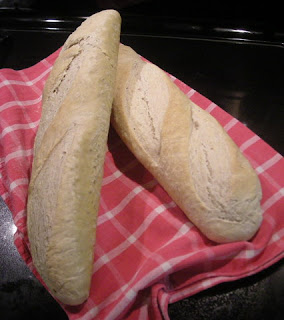 |
| Looks like it came from a bakery, doesn't it? |
One thing that I really missed when I first came to Honduras was good, chewy bread so I've made most of our bread since we moved here. I'm sure Hondurans feel the same way about homemade tortillas when they move to another country. One of my favorite breads comes from a King Arthur Flour recipe for a rustic artisan bread, but since it requires planning in advance to make a 'poolish' the day before, I found that I had gotten into a rut making an easy Italian loaf. It was good, but not spectacular.
 |
| A different batch of bread |
If you aren't familiar with sourdough bread, you should know that 'sour' doesn't really mean that the bread has a sour taste. It's more of a tangy taste. El Jefe was confused about why I would want to make 'sour' bread. It didn't sound good to him at all. But just like sour cream or mantequilla blanca should not taste like sour milk, sourdough bread should just be tangy. Using 'sourdough starter' is a method of leavening bread without using purchased cultivated bread yeast. A pasty mixture of flour and water is allowed to sit and ferment, feeding it regularly once or twice a day until the natural yeasts grow. An even thicker mixture, called 'mother dough', is what the old settlers in the US carried with them to make bread on the wagon trains, and sourdough goes back thousands of years before that.
 |
| My sourdough starter |
Another way that sourdough starter can be maintained is by drying it. You just spread a thin layer on wax paper and let it dry. Once it is thoroughly dry, flake it off the paper and crumble it into a resealable plastic bag and store it in the freezer. As insurance against any mishaps that would require me to start all over, I keep two different batches in the refrigerator (just small amounts) and some dried starter in two different freezers. Sounds like belts and suspenders, doesn't it?
Experts used to be believe that the natural yeast came from the air of the particular location - hence, no one outside of San Francisco could make that famous San Francisco sourdough bread even if they used starter from San Francisco. Scientists even named a particular local yeast bacteria Lactobacillus sanfranciscensis. Now experts are saying that the yeast actually comes from the natural bacteria on the local flour used. So once you start feeding your starter mix with local flour, the flavor will change no matter where your starter came from.
In either case, the distinct flavor of your own starter will develop over time to represent your location. Not only the particular yeast bacterias in your local atmosphere, but the flour, air temperature, humidity, and elevation all can have effect on the taste of your bread. That is why I call mine Honduran sourdough bread, though more accurately, I should call it Ceibeño sourdough bread as the flavor would likely be different in other areas of Honduras.
Wikipedia has a very scientific article on sourdough bread, but the History of sourdough is very interesting and worth reading. Fresh Loaf has the starter recipe that I followed, but I can't find the original page with hundreds of comments and answers that helped me to figure out a lot of things. I'm sure it is there somewhere. There are other detailed sourdough articles and many recipes as well. Fresh Loaf has a real community of sourdough experts.
I'll tell you a little more about making the starter in the next article.


 Welcome to my Blogicito —
Welcome to my Blogicito — 







